ASM Metals HandBook Vol. 14 - Forming and Forging
Подождите немного. Документ загружается.


Fig. 3 Sequence of operations for producing stator and rotor laminations using single-
station dies. Operation 1,
stock blanked and pierced; operation 2, stator lamination notched; operation 3, rotor lamination separated
from stator lamination; operation 4, rotor lamination notched. Compare with Fig. 4.
Single-station dies can be used for punching any lamination, regardless of the size, composition, shape, or quality
requirements. However, because production with single-station dies is relatively slow, the cost per piece is high for mass
production. Laminations such as those shown in Fig. 1 can be produced in large quantities at a lower cost in progressive
dies.
The size of the workpiece and the quantity required influence the degree to which operations can be combined and the
complexity of any one die. For example, in Fig. 3, the slots made in operations 2 and 4 can be punched in one stroke in a
multiple die for each operation if the die sections are strong enough. An alternative method is to punch the slots in 28
strokes with a single-notch die in a high-speed notching press equipped with an indexing mechanism. Single-notch dies
are used in the production of laminations for the following reasons:
• Tool costs are lower, and the single-
notch die can be used on several different laminations. The cost is
sometimes less than 5% of that for a multiple die that c
an pierce all the holes and slots in one press
stroke
•
Laminations more than about 380 mm (15 in.) in diameter are sometimes too large to be notched by any
other method because of tool and equipment costs. However, many larger-
diameter laminations are
multiple pierced
• Limited production does not warrant the cost of a multiple die
• Available equipment must be used
Progressive dies perform a series of operations at two or more die stations during each stroke of the press. Each
working, or active, station in the die performs one or more operations. The work material progresses through successive
stations until a completed part is produced (Fig. 4). Idle stations, in which no work is performed, are added to provide
strength to the die, to facilitate material travel through the die, to simplify construction, or to increase flexibility for die
changes.

Fig. 4 Blanking and piercing sequence for rotor and stator laminations in a five-
station progressive die. Two
pilot punches were used at each station. Station 1, pierce pilot holes, rotor slots, and rotor-
shaft hole; station
2, pierce stator rivet holes and blank rotor; station 3, pierce stator slots; station 4, idle; station 5, blank stator.
Compare with Fig. 3.
One of the more common progressive dies used in the electric-motor industry is a five-station die that produces a rotor
lamination and a stator lamination with each stroke of the press (Fig. 4). This die can be provided with carbide inserts for
the punch and die sections. It has a spring-actuated guided stripper. The die components are mounted on a precision die
set with ball bearing guide bushings and hardened guide pins. Slender punches are guided through the stripper by
bushings. Such a die usually has four active stations and one idle station.
The progressive die described above is the blanking or scrap-all-around type. For the most efficient use of material, the
cutting-off or parting methods of severing the blank from the strip are used where layout permits.
The principal advantages of progressive dies for blanking laminations are:
• Handling between operations is eliminated; therefore, cost per piece is lower
•
Laminations from progressive dies are generally stacked in chutes that allow the press to be operated at
uninterru
pted maximum capacity. Stacking chutes fastened to the bottom of the bolster or die shoe keep
the laminations oriented in a smooth, uninterrupted flow from the die. Therefore, laminations are better
controlled with regard to burr direction and are easier to handle for assembly
Two disadvantages of progressive dies for blanking laminations are:
• A progressive die is, to a great extent, a single-
purpose die. Even a minor change in part design can
necessitate an expensive die alteration or can make the die obsolete
• Progressive dies are more susceptible to damage from accidents than single-
station dies. Progressive
dies run at high speed and may make many strokes before the press can be stopped. Misfeed detectors
built into the die can help prevent damage. Di
e damage can halt production in progressive operations. In
single-
station operations, if the inventory of processed material is sufficient to keep other dies running, a
breakdown of a die does not interrupt production
The minimum size of lamination that can be made depends on the slot size and spacing, work metal thickness, and
tolerances on the slot dimensions. The die must be strong enough to withstand the blanking pressure. Figure 5 shows
some very small laminations that were made in progressive dies. The 6.48 mm (0.255 in.) diam rotor was made in three
stations in order to have the necessary die strength. Part tolerances were such that piercing in three stations produced
acceptable parts.
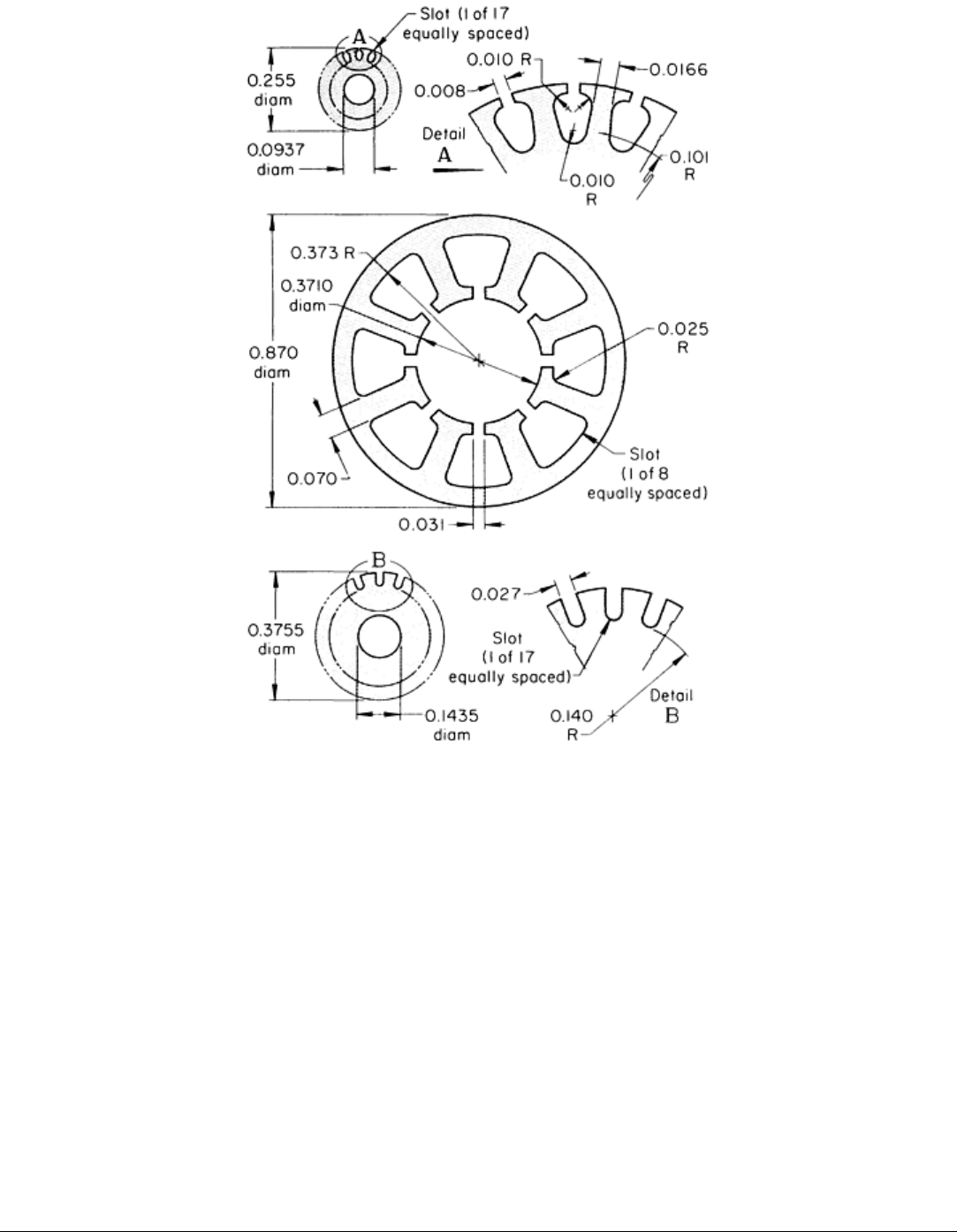
Fig. 5 Small-diameter laminations produced in progressive dies. Dimensions given in inches.
The dies for producing laminations are usually of segmented construction, which provides maximum accuracy. However,
electrical discharge or electrochemical machining methods have been used to produce satisfactory dies.
There is no agreement as to the maximum size of lamination that can be efficiently produced in progressive dies.
However, progressive dies are seldom used for laminations larger than 380 mm (15 in.) in major dimension. The factors
that limit the maximum practical size are as follows:
•
Progressive dies for making laminations more than 380 mm (15 in.) in major dimension represent a
large investment (and a significant loss if damaged)
• Quantity demands are usually lower for large laminations; therefore, the investment is not warranted
• Extremely large dies may require a press capacity that is so large as to be impractical
•
Problems from camber and lack of flatness in the stock are magnified in stamping large laminations in
progressive dies
Blanking and Piercing of Electrical Steel Sheet
Selection of Die Materials

Almost any hardened tool steel is satisfactory as die material for making a small quantity of laminations. However, for
production blanking and piercing, either a high-carbon high-chromium cold-work tool steel, such as AISI D2, or carbide
must be used to resist the abrasiveness of electrical steels.
The shape or size of the lamination seldom affects the choice of die material. Dies ranging from the smallest to the largest
and from the simplest to the most complex have been made from both high-carbon high-chromium tool steel and carbide.
In addition, both die materials have been used to blank and pierce all compositions and thicknesses of electrical sheet. The
composition and thickness of the stock rarely affect the choice between carbide and tool steel.
Production Quantity. If the dies are of the same design and construction, the total quantity of parts to be produced is
the major factor in choosing die material. If the run is so short that it can be made with tool steel dies without sharpening,
tool steel is more economical. However, for longer runs, carbide dies have 10 to 20 times as much life per grind as tool
steel dies.
Uniform quality of cut edges and minimum burr height will be retained over a much longer run by carbide dies than
by tool steel dies. In some cases, the edge condition of the lamination is not critical. However, when automatic stacking
and core assembly equipment is used after blanking and piercing, burr height is important. Excessive burr height can
cause short circuiting of the laminations in the core.
Cost. Depending on size and design, a die with carbide cutting edges will cost at least 1 times as much as a steel die.
However, in terms of cost per piece, carbide dies may be more economical. Press downtime and die maintenance affect
cost per piece; carbide dies can run about ten times as long per sharpening as tool steel dies.
Press condition is important in the operation of blanking and piercing dies. To achieve the maximum potential usage
of carbide dies, press condition must be maintained at a high level. Although tool steel punches and dies can chip and
shear because of misalignment, carbide punches and dies are more likely to break. Therefore, the presses used for tool
steel dies can be in less than top level condition and continue to produce quality laminations.
Blanking and Piercing of Electrical Steel Sheet
Effect of Stock Thickness
Electrical sheet that is to be blanked and pierced usually ranges in thickness from 29 to 24 gage (0.343 to 0.607 mm, or
0.0135 to 0.0239 in.). Thinner or thicker stock is used for special applications. The blanking and piercing of extremely
thin electrical sheet requires close control of equipment and technique. The processing of thick sheet (>1.27 mm, or 0.050
in.) can also cause difficulty, although the force-capacity rating of the press is the major factor that determines the
maximum thickness of sheet that can be blanked and pierced.
Punch-to-die clearance for electrical sheet generally ranges from 3 to 7.5% of stock thickness per side, with clearances as
large as 20% reported for grain-oriented stock. These values are similar to those used for low-carbon steel, but the stock
thicknesses are thinner than those commonly used for the low-carbon steels. This results in close die clearance and
requires good diemaking practice and accurate press equipment.
Thin Sheet ( 0.254 mm, or 0.010 in.). Under carefully controlled conditions, laminations can be blanked and
pierced from sheet as thin as 0.051 mm (0.002 in.), but the press must be in top condition. Further, the feeding mechanism
must be capable of feeding within ±0.076 mm (±0.003 in.) total error per stroke at a feed rate of 23 m/min (900 ft/min).
Punches and dies of hardened tool steel, such as D2, or carbide are satisfactory, although carbide dies and punches will
have at least ten times the life of their tool steel counterparts. The punches must be rigidly supported and guided. The
entire tool must be made rugged and accurate enough to maintain alignment. To avoid shearing the punch and die during
press setup, it is important that the die be handled carefully to prevent the possibility of some of the components moving
out of alignment. The press bed, the bottom of the die shoe, the face of the press slide, and the top of the punch holder
must be clean and free of any irregularities that would cause a deviation from parallelism.
The punch and the die as a unit should be aligned square with the centerline of the press. The press slide should then be
brought down slowly to meet with the top of the punch holder, and the punch holder should be fastened to the face of the
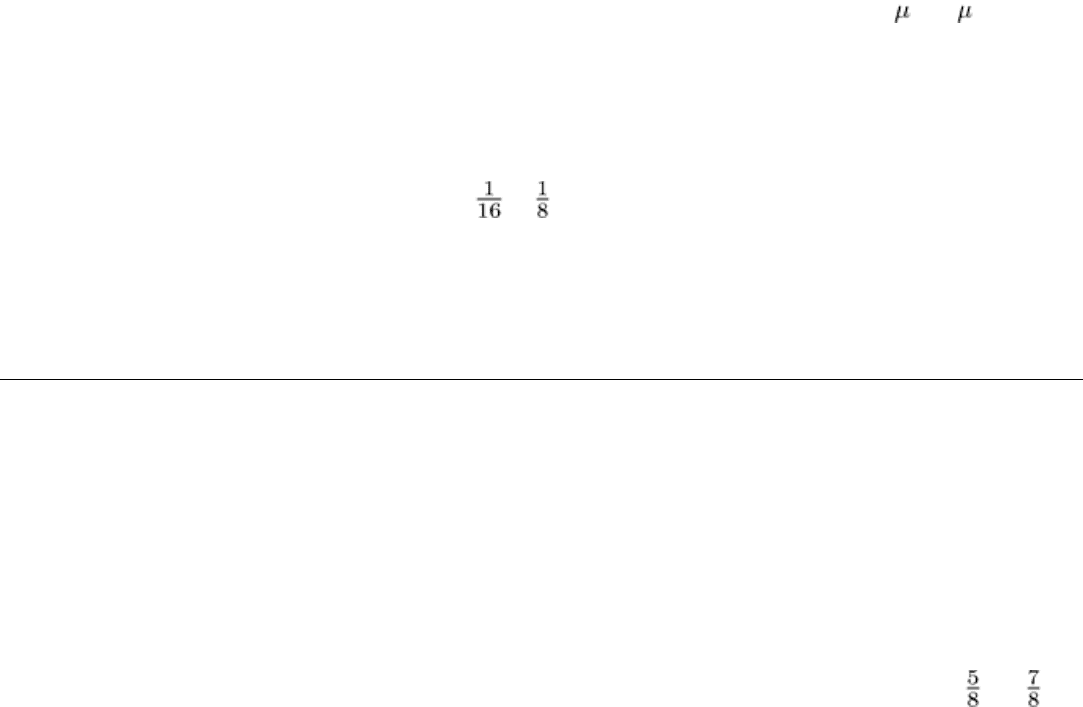
slide. The slide should then be adjusted downward so that the punches enter the die cavities. Finally, the die shoe should
be fastened to the bolster or press bed.
Dies with this close clearance are often designed as a unit, and the die is not fastened to the press ram. Therefore, the tool
is not subject to the inaccuracies of the press.
A back taper of 0.002 mm/mm (0.002 in./in.) per side is commonly used in the die. Because of this angular clearance in
the die, total die life is limited by the maximum punch-to-die clearance that can be tolerated. Each time a die having a
back taper of 0.002 mm/mm (0.002 in./in.) per side is sharpened, the hole diameter will increase 0.1 m (4 in.) for each
0.0254 mm (0.001 in.) ground from the top of the die. After grinding 2.54 mm (0.100 in.) from the die, the punch-to-die
clearance will increase 0.005 mm (0.0002 in.) per side.
If this amount of clearance is too great, the original clearance can be restored by installing new die sections or, if the
dimensional tolerance permits, by using an oversize punch. The amount that can be removed from the die depends on the
amount of back taper in the die, the stock thickness, and the maximum punch-to-die clearance permissible. Dies
sometimes have a straight land that is 1.6 to 3.2 mm ( to in.) wide before beginning the back taper.
Lubricant is applied to the stock during blanking and piercing to keep wear on the cutting edges of the punch and die at an
acceptable level. Use of a water-thin lubricant with rapid evaporation and low residue makes it unnecessary to perform a
burn-off operation before hydrogen annealing. Difficulties in producing acceptable laminations from thin sheet are
magnified as the plan area of the lamination increases.
Blanking and Piercing of Electrical Steel Sheet
Effect of Work Metal Composition and Condition on Blanking and Piercing
Each of the three most widely used electrical sheet materials (low-carbon steels and nonoriented and grain-oriented
silicon steels) has distinctive punching characteristics. These characteristics often necessitate specific procedures to
produce laminations of the desired quality at the lowest cost.
Low-carbon steels such as 1008 are used as electrical sheet when their electrical properties can meet requirements,
primarily because they cost less than silicon steels and the cost is lower for blanking and piercing. More pieces per die
sharpening are usually obtained in blanking these steels than in blanking silicon steels. One study of die wear in making
stator and rotor laminations similar to those shown in Fig. 1 and ranging in diameter from 92 to 149 mm (3 to 5 in.)
showed that, with tool steel cutting edges, 120,000 to 150,000 pairs were punched per sharpening when stamping 1008.
The condition of the low-carbon steel stock influences power requirements and punching characteristics. When annealed,
this steel has a tensile strength of 380 to 414 MPa (55 to 60 ksi), but the strength of full-hard material may be over 690
MPa (100 ksi). Therefore, the material condition must be known before the force-capacity requirements of the presses can
be determined. Low-carbon low-silicon steels in the annealed condition are soft, and they are likely to roll at the edges
and form excessive burrs. Therefore, punch-to-die clearances must be as close for these steels as for electrical sheet of the
same thickness. An annealed product is usually specified, but whether annealed stock is stamped or individual
laminations are annealed after stamping is often a matter of convenience, because of press capacity, annealing facilities,
or other factors.
Nonoriented silicon steels are available with silicon contents ranging from 0.5 to 3.25%. As silicon content
increases, the sheet becomes more brittle and more abrasive. As a result, the edges of higher-silicon steel are less likely to
roll and make excessive burrs, but die wear is increased because of abrasion.
Many nonoriented silicon steels are coated with an organic or inorganic material (core plating) to insulate one lamination
from another. This organic core plating also improves the punchability of electrical sheet. In one application, carbide dies
produced about 3.5 million laminations from core-plated M-36 (2.5% Si) between resharpenings. When similar
laminations were produced from uncoated M-36, dies required sharpening after each 1.2 million parts. Heating of the
coated blanks by welding or die casting may destroy the organic coating. Additional information is available in the
section "Core Plating" in this article.

General practice is to use approximately the same punch-to-die clearances for all silicon steels. The tensile strength of the
particular steel must be considered in determining press capacity because silicon steels may vary in strength, depending
on whether they are fully annealed at the time of stamping.
Oriented silicon steels are relatively high in silicon (3.15% Si + Al) and have most of their grains (crystals) oriented
with the cube edges parallel with the rolling direction and face diagonals at 90° to the rolling direction ({110} <001>).
Because of this orientation, these steels have blanking and piercing characteristics that are different from those of
nonoriented steels. Tensile strength will vary as much as 20% between the rolling direction and the transverse direction
(strength is greater parallel with the rolling direction).
A magnesium hydroxide coating is applied to grain-oriented steel after normalizing. This coating prevents the coiled strip
from welding together during annealing. Magnesium hydroxide, in contrast to the organic coatings, is highly abrasive and
greatly increases die wear; therefore, it is not recommended for stamped laminations. Tool steel dies wear so rapidly
under these conditions, because of the high silicon content of the steel, that carbide cutting edges are almost always used
for the blanking and piercing of grain-oriented steel.
Because mechanical properties vary with direction, cutting properties also vary in grain-oriented steels. Cutting across the
rolling direction results in a clean break, but the edges are smeared when cutting is parallel with the rolling direction.
Therefore, punch-to-die clearance is more critical on the sides parallel with the rolling direction.
Blanking and Piercing of Electrical Steel Sheet
Camber and Flatness
Camber in electrical sheet is the deviation (parallel to the stock surface) of a side edge from a straight line that extends to
both ends of the side, and it is customarily limited to 6.4 mm ( in.) for any 2.5 m (96 in.) length or fraction thereof.
Flatness, or the degree to which a surface of a flat product approaches a plane, is expressed in terms of the deviation from
a plane. Flatness tolerances have not been established for electrical sheet; the operations employed to flatten other steel
products cannot be used because of their effect on magnetic quality. Flatness requirements should be specified for a
particular application.
Camber and flatness are interrelated; the edge of a 2.5 m (8 ft) section of sheet may come within the 6.4 mm ( in.)
tolerance while lying freely on a flat surface. However, the seemingly flat sheet may have a number of faint waves
(sometimes called oil cans). If this sheet is then flattened (as it is in dies), the flattening of these waves causes
multidirectional elongation of the sheet, and the edge of the sheet may then be forced into a camber different from that
when the sheet is not under flattening pressure. Minimum camber and maximum flatness are desirable for blanking
electrical sheet and are especially important in progressive-die operations.
Effect on Progressive-Die Operation. If there is no camber, it is easy to start the stock through the die correctly by
aligning the straight edge of the sheet against a straight-edge starting guide, with the end of the material covering the first
die stage. Feed rolls are then engaged, and the blanking and piercing can begin.
Even though the edge of the sheet is cambered, it must still be used in the starting alignment. Therefore, the material may
be misaligned to some degree as it enters the die. A small degree of misalignment is not readily apparent to the press
operator.
Minor misalignment in starting the material through a progressive die may not cause immediate problems. Operating
difficulties result from various misalignments, which have a cumulative effect.
In the first stage of the die, pilot holes are pierced into the sheet, often into a portion that will later be scrap. At subsequent
die stations, bullet-nose pilots engage the pilot holes as the die closes. The piloting action may cause the sheet to move
slightly into true position before the cutting edges of the die meet the sheet. Powered feed rolls move the sheet between
press strokes to an approximate position for the next die station. The feed rolls then open, releasing the sheet so that there
is no conflict between the locating action of the pilots and the feed rolls.
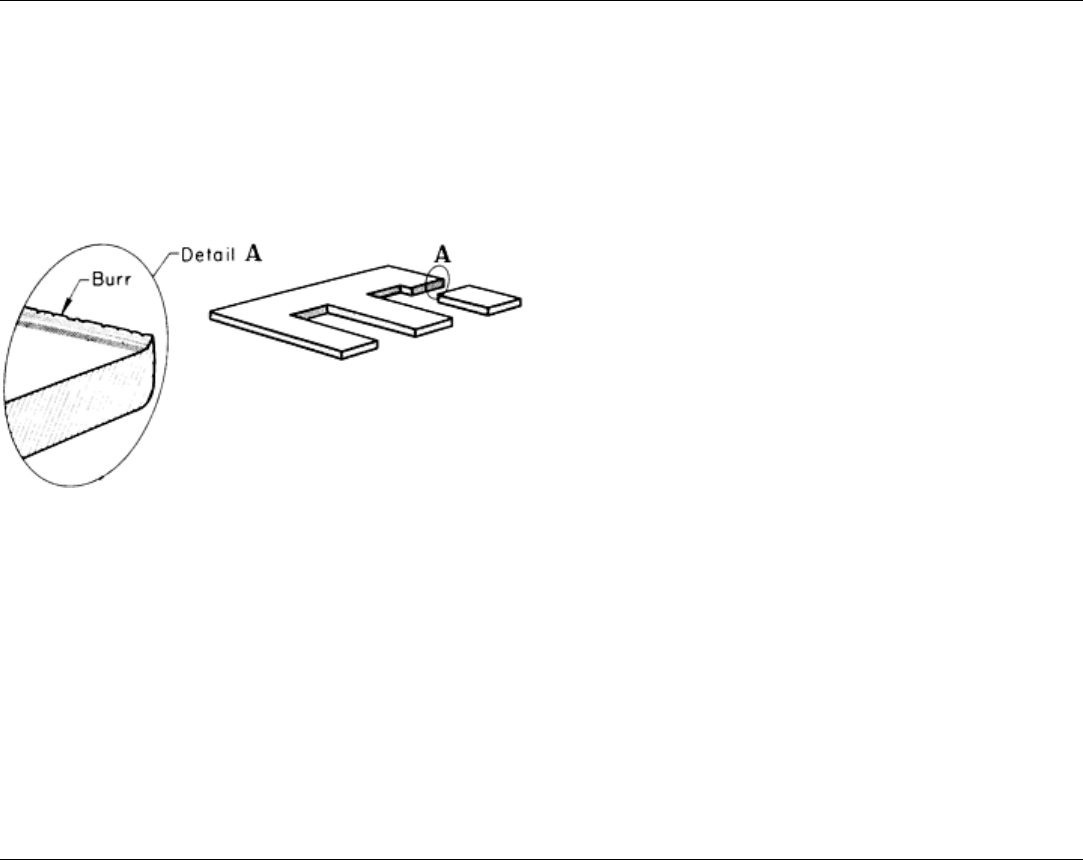
When the original lineup is not correct or when there are cumulative effects of camber against the stock guides, the sheet
may wander from side to side on the die face. Stock guides are provided in progressive dies to limit wandering due to
camber and misalignment.
Interference between the pilots and the stock guides may cause the stock to distort and jam in the die, preventing proper
flow of the stock. If the stock jams, the press must be stopped at once.
Camber can cause other difficulties. For example, a change in camber or multidirectional elongation of the sheet as the
press flattens the waviness may cause the pilots to distort the piloting holes; thus, misaligned rotor and stator laminations
are made. This leads to misalignment of the slots in the stacked core. As slots are blanked out, stresses are released that
also can change the amount of camber and flatness.
There is no single solution to the problem of camber in the production of laminations in progressive dies, because no two
shipments of material are exactly alike. Some manufacturers of laminations use less efficient single-station dies because
of difficulties with camber, even though production volume could justify the use of progressive dies. Other manufacturers
use progressive dies only for laminations below a certain size.
Blanking and Piercing of Electrical Steel Sheet
Burr Height
It is impossible to blank and pierce laminations without producing some burr along the cut edges (Fig. 6). The amount of
burr (measured as burr height) depends on the composition and condition of the electrical sheet, the thickness of the sheet,
the clearance between punch and die, and the edge condition (sharpness) of the punch and die.
The amount of burr that can be tolerated depends on end
use. Burr height influences the stacking factor, which in
turn influences magnetic characteristics. Maximum burr
height is usually limited to 0.05 to 0.13 mm (0.002 and
0.005 in.).
Length of Die Run. A die is usually run until the
maximum allowable burr height is reached, at which time
the punch and die are removed for sharpening. Close
control is required with this method of determining the
length of the die run.
Optimal Die Run. For the greatest economy and
convenience of operation, die maintenance requirements
and die life (in addition to maximum burr height) should
be considered in determining the optimal die run. A die
should not be run too long before resharpening; otherwise, excessive stock must be removed from both the punch face
and the die face to restore the cutting edges. As a result, fewer laminations can be made during the life of a die.
A common method of determining the optimal die run is to establish an arbitrary number of pieces to be run before die
sharpening. At the end of this run, the punch face is sharpened. By knowing the number of pieces run and the amount
removed from the die during sharpening, the number of pieces produced per unit of length removed from the die can be
established. Using this procedure, the number of pieces run between sharpenings can be varied, an optimal die life
between sharpenings can be determined.
Blanking and Piercing of Electrical Steel Sheet
Lubrication
Although uncoated electrical sheet is sometimes blanked and pierced without lubrication, the use of some type of
lubricant is preferred. Organic core plate (used on nonoriented silicon steels) serves as a lubricant, and no further
lubrication is needed when blanking and piercing sheet that has core plating.
Fig. 6
Burr (exaggerated) produced along the edges of
a blanked lamination.
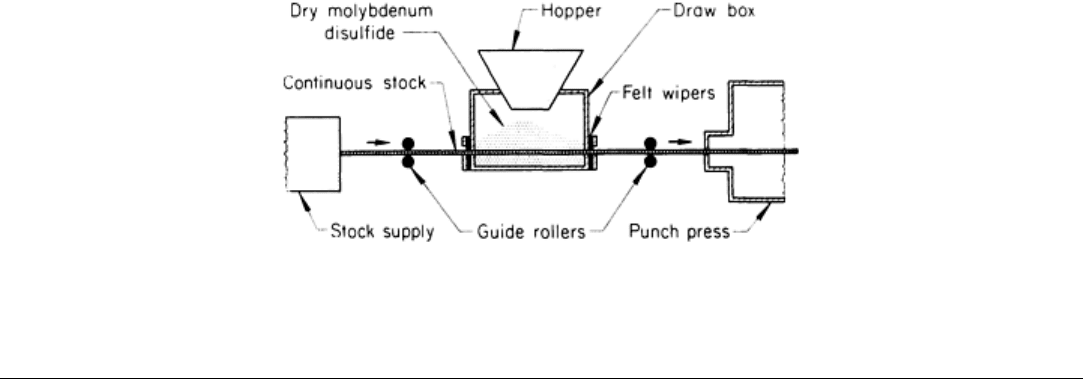
Tool life will be greatly improved by using a lubricant in the blanking and piercing of electrical sheet that has no coating
or has been coated with magnesium hydroxide, which acts as an abrasive rather than a lubricant. Oil-type lubricants, such
as those used in blanking and forming operations, are not ordinarily used for blanking and piercing electrical sheet,
because removal is too expensive.
Some plants purchase nonoriented silicon steel sheet without core plate and then subject the punched laminations to an
oxidizing anneal, in which the lubricant is burned off; the only requirement is to select a lubricant that will leave the least
residue when it is burned off. Water-soluble oils (1 part oil to about 20 parts water) have been used when annealing
follows punching. Other low-viscosity low-residue oils, such as the aliphatic petroleums, also burn off with little residue.
Liquid lubricants can be applied in several ways. In low-production operations, the work metal can be dipped into the
lubricant just before punching. In high-production operations, in which the stock is continuously fed, the lubricant can be
brushed on just before it enters the press, or it can be dripped onto the sheet a few feet from the press. The top of the sheet
is then rubbed with a felt wiper that spreads the lubricant over the entire surface. The bottom of the sheet can be coated
with lubricant by having a trough under the sheet that catches the excess drip. A piece of felt or similar material in the
trough acts as a wick to wet the underside of the moving sheet. A more complete discussion of lubricants is available in
the article "Selection and Use of Lubricants in Forming of Sheet Metal" in this Volume.
Molybdenum disulfide is a good lubricant for the blanking and piercing of electrical sheet. The amount used is usually
so small that no removal is required. When there is an excess, it can be removed by immersing the sheet for 4 to 5 min in
a dilute solution of stripper-type cleaner at 80 °C (180 °F).
Molybdenum disulfide is the basic ingredient of several compounds that are available as dry powder, paste concentrate,
and dispersion in liquid. A common method of applying dry molybdenum disulfide is shown in Fig. 7. The sheet passes
through a box containing the dry powder, and felt wipers remove the excess. A slurry can be used instead of the dry
powder. Sheets can also be coated by a spray timed with the stroke of the press; either powder or a liquid suspension can
be sprayed. In low-production operations, a liquid suspension of molybdenum disulfide can be applied to the sheet by
brush.
Fig. 7 Setup for applying dry molybdenum disulfide to both sides of electrical sheet.
Blanking and Piercing of Electrical Steel Sheet
Core Plating
Core plating, or insulation, is a surface coating or treatment applied to electrical steel sheet to reduce interlaminar loss and
sometimes to increase punchability. This treatment does not reduce eddy currents within the laminations. Interlamination
resistance is usually improved by annealing the laminations under slightly oxidizing conditions and then core plating.
Core plating can be classified as organic or inorganic.
Organic insulation generally consists of enamels or varnishes applied to the steel surface. Steels having organic
coatings cannot be stress relieved without impairing the insulating value of the coating, but the coating will withstand
normal operating temperatures. Coatings are about 0.0025 mm (0.0001 in.) thick.
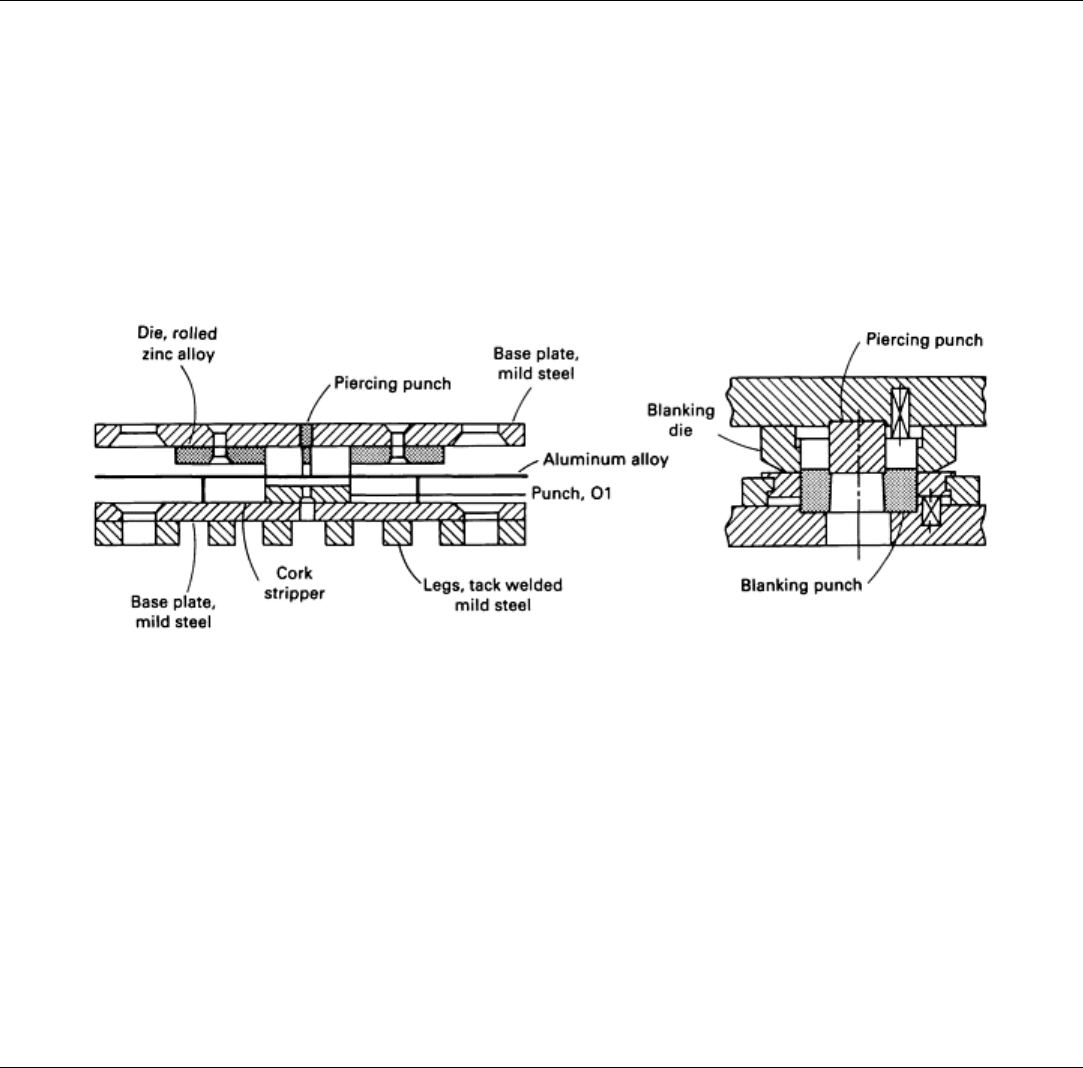
Inorganic insulation usually includes chemical or thermal treatments; it has a high degree of electrical insulation and
can withstand stress relieving. Inorganic coatings form a very thin surface layer on the steel and increase lamination
thickness only slightly.
Selection of Material for Blanking and Piercing Dies
Introduction
BLANKING AND PIERCING DIES, as discussed in this article, include the punches, dies, and related components used
to blank, pierce, and shape metallic and nonmetallic sheet and plate in a stamping press. The primary measure of the
performance of die materials in blanking and piercing service is the number of acceptable parts produced.
Sectional views of the blanking dies and the blanking and piercing punches used for making simple parts are shown in
Fig. 1. Parts that are more complex require notching and compound dies.
Fig. 1
Sectional views illustrating typical tools used for blanking and piercing simple shapes. Tooling at left is
for short-run production of parts similar to parts 1 and 2 in Fig. 2 made from relatively thin-gage metal.
Tooling
at right is for longer production runs.
A common indication of tool deterioration is the production of a burr along the sheared edge of the workpiece. When
tools are new, there is minimal clearance between punch and die, and the cutting edges are sharp. Under these conditions,
the break in the stock begins at the underside (the side not in contact with the punch) because there the stock is subjected
to the greatest tensile stress from stretching of the outer fiber. As more and more parts are produced, the cutting edges of
the punch and the die become rounded by wear, and the stress distribution in the stock is changed. Stress on the underside
is reduced, breaking at that point is delayed, and deformation accompanied by work hardening occurs. When breaking
starts, it nucleates from both sides simultaneously, and a burr develops on both the slug and the surrounding area of the
sheet from which it was cut. The height of this burr increases with tool wear. Acceptable burr height varies with the
application, but is usually between 0.025 and 0.125 mm (0.001 and 0.005 in.).
Selection of Material for Blanking and Piercing Dies
Materials for Specific Tools
The compositions and properties of the tool materials referred to in this article are presented in Properties and Selection:
Irons, Steels, and High-Performance Alloys, Volume 1 of the ASM Handbook.
Punches and Dies. Table 1 lists typical materials for punches and dies used for blanking parts of different sizes and
degrees of severity from several different work materials about 1.3 mm (0.050 in.) thick in various quantities. Illustrations
of typical parts are presented in Fig. 2. Typical materials for the punches and dies used to shave several work materials of
this same thickness in various quantities are listed in Table 2.
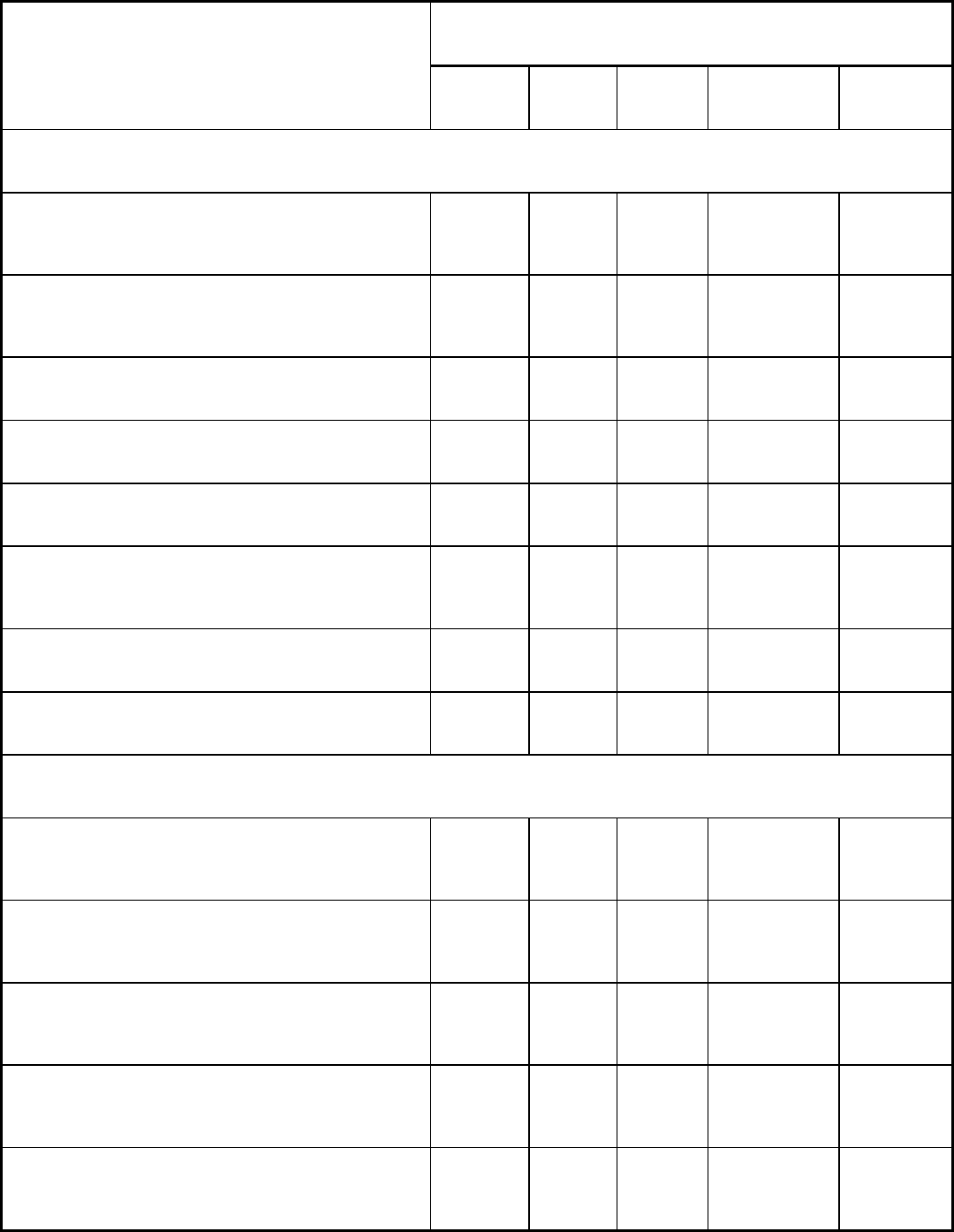
Table 1 Typical punch and die materials for blanking 1.3 mm (0.050 in.) sheet
See Fig. 2 for illustrations of typical parts.
Tool material for production quantity of:
Work material
1000 10,000 100,000 1,000,000
10,000,000
Part 1 and similar 75 mm (3 in.) parts
Aluminum, copper, and magnesium alloys Zn
(a)
, O1,
A2
O1, A2 O1, A2 D2, CPM 10V
Carbide
Carbon and alloy steel, up to 0.70% C, and ferritic stainless
steel
O1, A2 O1, A2 O1, A2 D2, CPM 10V
Carbide
Stainless steel, austenitic, all tempers O1, A2 O1, A2 A2, D2 D4, CPM 10V
Carbide
Spring steel, hardened, 52 HRC max A2 A2, D2 D2 D4, CPM 10V
Carbide
Electrical sheet, transformer grade, 0.64 mm (0.025 in.) A2 A2, D2 A2, D2 D4, CPM 10V
Carbide
Paper, gaskets, and similar soft materials W1
(b)
W1
(b)
W1
(c)
,
A2
(d)
W1
(d)
, A2
(d)
D2, CPM
10V
Plastic sheet, not reinforced O1 O1 O1, A2 D2, CPM 10V
Carbide
Plastic sheet, reinforced O1
(e)
, A2 A2
(f)
A2
(f)
D2
(f)
, CPM 10V
Carbide
Part 2 and similar 305 mm (12 in.) parts
Aluminum, copper, and magnesium alloys Zn
(a)
,
4140
(g)
4140
(h)
,
A2
A2 A2, D2, CPM
10V
Carbide
Carbon and alloy steel, up to 0.70% C, and stainless steels
up to quarter hard
4140
(h)
, A2 4140
(h)
,
A2
A2 A2, D2, CPM
10V
Carbide
Stainless steel, austenitic, over quarter hard A2 A2, D2 D2 D2, D4, CPM
10V
Carbide
Spring steel, hardened, 52 HRC max A2 A2, D2 D2 D2, D4, CPM
10V
Carbide
Electrical sheet, transformer grade, 0.64 mm (0.025 in.) A2 A2, D2 A2, D2 D2, D4, CPM
10V
Carbide
